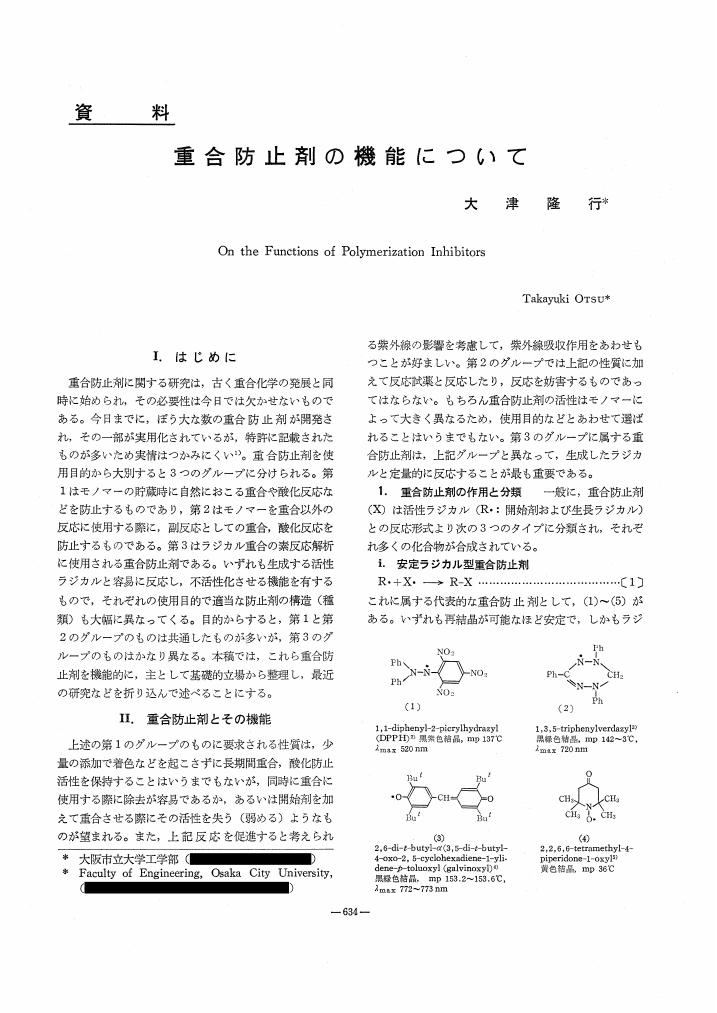1 0 0 0 OA 重合防止剤の機能について
- 著者
- 大津 隆行
- 出版者
- The Society of Synthetic Organic Chemistry, Japan
- 雑誌
- 有機合成化学協会誌 (ISSN:00379980)
- 巻号頁・発行日
- vol.33, no.8, pp.634-640, 1975-08-01 (Released:2009-11-13)
- 参考文献数
- 43
- 著者
- 西川 幸利 大津 隆行
- 出版者
- 社団法人 日本化学会
- 雑誌
- 工業化学雑誌 (ISSN:00232734)
- 巻号頁・発行日
- vol.72, no.8, pp.1836-1841, 1969
- 被引用文献数
- 16
α-およびβ-置換アセチルアセトンを合成し,その銅(II)キレートによるメタクリル酸メチルの重合を,60℃,塊状で行なった。α-位にメチルおよびフェニル基を導入した場合には,重合活性は増大し,またフェニル置換体についてはつぎのような順であった:<I>p</I>-CH<SUB>3</SUB>O><I>p</I>-H><I>p</I>-CH<SUB>3</SUB>><I>p</I>-Cl。一方,β位に置換基を導入した場合には,つぎの順であった:C<SUB>2</SUB>H<SUB>5</SUB>O>CH<SUB>3</SUB>>C<SUB>6</SUB>H<SUB>5</SUB>。このような重合活性におよぼす置換基の効果は,主として置換基のI効果と生成リガンドラジカルの安定性によって理解された。<BR>また,これらキレートによる開始機構をさらに明らかにするためにアセト酢酸エチル銅(II)キレート([Cu(eacac)2])によるスチレンの重合(60℃)を動力学的に研究した。ベンゼン中では重合速度(<I>R</I>p)は次式で表わされた:<I>R</I>p=k[Cu(eacac)<SUB>2</SUB>]<SUP>0.5</SUP>[St]<SUP>1.9</SUP>。<BR>ベンゼン以外の他の溶媒を用いた場合には,<I>R</I>pに対するみかけのモノマー次数は1.3から2.4まで変化した。このことは,開始過程においてキレートとモノマーあるいは溶媒との間での錯体形成が重要であることを示している。得られた置換基効果ならびに動力学的結果から,金属キレートによるビニル重合の開始機構について考察した。
1 0 0 0 OA アセチレンアルコールとその誘導体に関する研究 (第11報)
- 著者
- 大津 隆行 的場 啓子 菊地 茂行 平尾 一郎
- 出版者
- 公益社団法人 日本薬学会
- 雑誌
- YAKUGAKU ZASSHI (ISSN:00316903)
- 巻号頁・発行日
- vol.75, no.4, pp.368-371, 1955-04-25 (Released:2010-02-19)
- 参考文献数
- 8
- 被引用文献数
- 3
Polyvinylpyrrolidone, used as the substitute plasma, is said to be effective when the molecular weight is around 30, 000 to 50, 000, and the inclusion of lower or higher molecules is thought to give adverse effect as a substitute plasma. The polymer obtained by the polymerization of vinylpyrrolidone with hydrogen peroxide and ammonia catalyst was extracted with acetone at a room temperature and fractionated by reprecipitaton from aqueous solution with acetone, obtaining a distribution curve for molecular weights.On the other hand, distribution curve of molecular weights was also obtained by the same method from the polyvinylpyrrolidone marketed by the German Bayer and the two curves were found to be very similar. These results show that the extraction of low molecular polymers with a solvent like acetone is effective in obtaining polyvinylpyrrolidone of high homogeneity. Polyvinylpyrrolidone is known to take a coiled form in a solution that its viscositic characteristics in dilute aqueous solution were also examined and it was observed that the Huggins' viscosity constant, k', markedly changes with the degree of polymerization.
